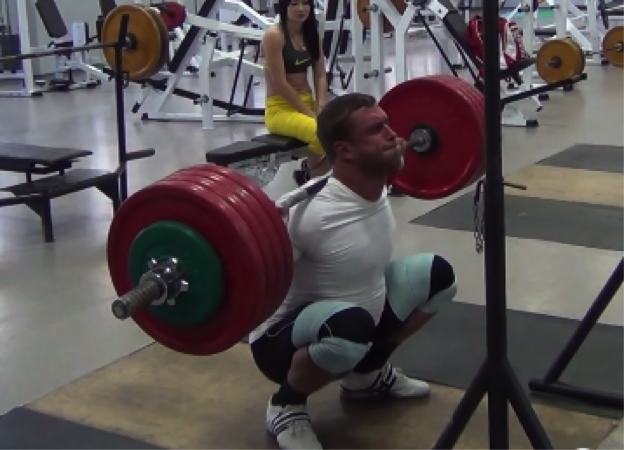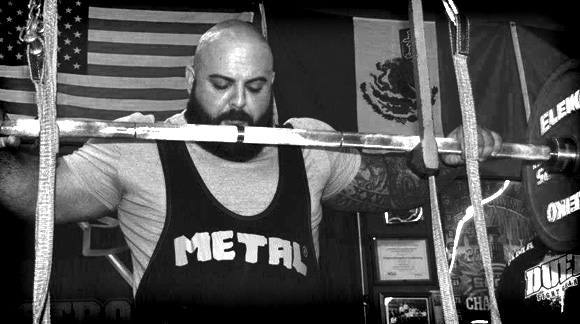Written by Chad Wesley Smith As the Juggernaut Squatapalooza rolls on, check out the first three parts of this series if you’re just tuning in: Part 1: Setting up for a Huge Squat Part 2: Dont Get Stapled – How to Make it Through Your Sticking Point Part 3: 10 Steps to Great Squatting Technique
Which kind of squat is best? That kind of question is where heated internet arguments are born.
I’ll throw in my $.02 and let you know which squatting types I prefer for different sports/goals.
Powerlifting
The goal of the squat in powerlifting is simple: lift the most weight. With that in mind, whichever technique allows you to do this is the one you should use. There will be coaches and lifters that argue until they are blue in the face that the low bar squat is king or a certain stance width is best and so on and so on, but the reality of the matter is that the answer is unique to the individual and their own strength and leverages. With that being said, lets take a look at the compilation of lifters below…
Here are 6 of the world’s strongest squatters, and while this is obviously a very small sample size, there are clearly a lot of similarities in the positions these athletes are in during their squats. All of these athletes are using a lower bar position and a medium or wider stance, though I wouldn’t call anyone of them a wide stance, especially relative to what you see among multi-ply lifters. The styles that these lifters use is what they have found to be best for them – you aren’t built the same as any of them so you need to find what is best for you. Whatever you find, you will need to practice that technique and develop strength in that specific movement pattern. While your specific technique should be at the forefront of your training, other variations including high bar, front squat, close stance, wide stance, etc. all have their place in your training and will all be good variations to include.
Weightlifting
I’m not a weightlifting coach and I don’t profess to be, but I am smart enough to look at sporting movements – and I have enough high-level weightlifting coaches as friends – to confidently tell you that the only squatting variations the Olympic weightlifter needs to concern his or herself with are high bar Olympic squats and front squats.
The low bar squat, causing a forward leaning torso angle, is not for weightlifters to use. This will reinforce bad habits and bad angles for your catch position. Do not do them.
The squat is not a competitive movement in weightlifting, so despite how important it is, its purpose is to drive the development of the competitive lifts, so perform them in a manner that will achieve this.
Any questions regarding the squat for weightlifting (or just any questions about life) should be cleared up here…
Success in strongman requires massive strength in many different angles and leverages, and your squat training should reflect that. The squat is rarely a competitive event in strongman, and even when it is, there is almost always something unique to it (squat til weight touches blocks, squat/front squat with axle, squat on a fixed apparatus) so specificity is less important here.
There is merit to training a variety of stances and bar positions to develop your ability in strongman. Keep your strongest technique as the foundation of your squat training for strongman, as this will give you the strongest stimulus by allowing you to handle the most weight, and use a rotation of exercise variations to complement it. High bar, low bar, front squat, wide stance, close stance, specialty bars, box squats, pause squats and dead squats can all be useful variations to develop your squatting strength for strongman. Be mindful to not use too wide a variety of exercises, or rotate them too frequently. You want to make sure you’re actually able to gauge improvement and be able to tell what’s having carryover to strongman performance.
CrossFit
CrossFit shares many more similarities with weightlifting than it does with powerlifting, so with that in mind, competitive CrossFit athletes should heed my earlier advice and keep their squat training exclusive to the high bar back squat and front squat.
Another thing to consider with the training of competitive CrossFit athletes and the squat, is that due to the extremely high volume and variety of skills and movements they need to be proficient in, and the fact that max squats are rarely contested, it wouldn’t make much sense devote excessive energy to pure squat development. You need to squat well to build your Olympic lifts and bolster your lower-body-dominant skills but that can be achieved with only those two previously-mentioned variations, and you do not need anything exotic to drive your squat to the necessary levels.
Sports Performance
What’s more functional, the back squat or front squat? How deep should athletes squat? What kind of stance is the best for athletic performance? Do these questions keep you up at night? Well stop it because it doesn’t really matter.
Sports (non-strength sports) aren’t played with barbells and because of that barbell movements are general exercises and general exercise selection isn’t worth agonizing over.
Are there exercise choices that are better than others – of course but that will depend on factors that go beyond the scope of this article, like which sport you’re competing in, where you are in the annual plan, the athlete’s preparedness, athlete’s position and more.
Those factors aside, there are 3 main principals that should guide your exercise selection for athletes.
1) Can the athlete execute the movement safely and properly?\
2) Can the athlete create significant stimulus training effect with the exercise?
3) Does the exercise fit well within the context of the athlete’s entire training plan?
Some athletes just aren’t well-suited for certain movements and can’t perform them effectively. Since there aren’t any weightroom movements that are prerequisites for sporting success, they don’t have to do that movement and can find a suitable replacement or alternative.
If an athlete can’t move some weight in an exercise, especially a foundational movement like the squat, then it probably isn’t a good choice for their training plan, at least not in a primary role. So you may love front squats for athletes but if you have an athlete who is terrible at them but good at box squats or front box squats, then you should choose the option they can get more stimulus from.
The final consideration when choosing a squat variation for the athlete is how it fits into the entire training plan. In-season, the primary objective of the athlete is to practice and play well, so choosing an overloaded squat option (like squats with chains/bands or pin squats) that is very demanding on the CNS wouldn’t be a good idea because it would detract from the athlete’s ability to practice. In-season using an option like front squats (which are inherently lighter than back squat variations) or box squats (which are less stressful) are good options to allow for more energy to devote towards skill development.
The squat is a valuable exercise to strength athletes and team sport athletes alike but it serves different roles in different sports. Hopefully these ideas have given you a good jump on properly selecting squatting styles for you and your athletes.
Like what you’ve read so far? Even more top-quality material, including squat seminars with live Q&A, is coming to Strong360 soon.
















